There is no denying the popularity of Indonesia tour packages for couple vacations and honeymoons, but for most people, Indonesia means the beaches of Bali and the metropolitan experience of Jakarta. Indonesia has also been known for its numerous Buddhist artefacts, temples, and monuments. Among the innumerable Buddhist temples in Indonesia, is Borobudur Temple, which is known to be one of the most famous Buddhist monuments in the world.
The World’s Largest Buddhist Temple
Surrounded by a mysterious history, the Borobudur Temple is one of the most significant pieces of the cultural heritage of Buddhism. The temple sits nestled in the heart of central Java and is a testament to the craftsmanship of ancient times. The temple boasts of impressive architecture and deep cultural significance. Here is all you need to know about the Borobudur Buddha Temple of Indonesia:
- The Borobudur Temple
- Borobudur Temple: Location
- Borobudur Temple: History
- Borobudur Temple: Rediscovery
- Borobudur Temple: Architecture
- Borobudur Temple: Information for Visitors
- Borobudur Temple: Things to Know Before Your Visit
- Borobudur Temple: Interesting Facts
The Borobudur Temple
Believed to date back to the 8th and 9th centuries, the Borobudur Temple is a massive Buddhist temple located in central Java. Also known as the Borobudur Mandir, this temple has been built in three tiers. The first tier has a pyramid base with five square terraces built concentric to each other. The second tier has three circular platforms and the trunk of a cone, while the third tier has a stupa at the top. In Indonesia, the Borobudur Temple is believed to be where Mahayana Buddhism was born in central Java. The grandeur and complexity of the temple are an artistic representation of Buddhist values, with the architecture of the Borobudur Temple conveying the traditions of ancient times. The temple compound is believed to be Lord Buddha’s holy representation and is one of UNESCO’s World Heritage Sites that travellers simply must visit at least once.
Borobudur Temple: Location
The location of the Borobudur Temple is close to Yogyakarta, at a distance of about 40 kilometres, while Surakarta lies around 86 kilometres from the temple. Borobudur Temple is located between twin volcanoes, Merbabu-Merapi and Sundoro-Sumbing, and between the rivers of Elo and Progo. The location of the Borobudur Temple falls on a straight line that connects three Buddhist temples in the region – the Borobudur, Mendut, and Pawon Temples.
Borobudur Temple: History
The history of the Borobudur Temple is not very clear. In fact, no actual evidence has been found that proves the real existence and purpose behind the construction of the Borobudur Temple. The approximate establishment of the temple has been evaluated from the inscription that is carved on the hidden foot of the temple. There is a lot of confusion about the temple being built during the period of Hindus or Buddhists. It is believed to have been constructed during the Sailendra Dynasty, which many believe to be Buddhists. However, the script carvings of the dynasty suggest that they may have been Hindus. During the period when several recognised Hindu and Buddhist monuments were built in Indonesia, the Borobudur Temple is also believed to have been constructed.
Borobudur Temple: Rediscovery
Due to its location, the Borobudur Temple stayed hidden for a long time with thick forests and volcanic ash surrounding it. The existence of the Borobudur Mandir was a mystery until Indonesia came under the rule of the British. Lieutenant Thomas Stamford Raffles had a keen interest in the history of Java and came to hear about an important monument hidden within the forests. He appointed an engineer to find out more and had 200 men cut down the vegetation around the temple. That is how the hidden treasure, the Borobudur Buddha Temple, was discovered.
Borobudur Temple: Architecture
The architecture of the Borobudur Temple blends the Javanese architectural style with that of the Gupta dynasty, showcasing Indian and indigenous aesthetics. The Borobudur Mandir or the Borobudur Buddha Temple consists of six square levels that are topped with three circular platforms, with 2672 relief panels and 502 statues of Lord Buddha. Seventy-two statues of Lord Buddha are placed around the periphery of the central stupa which is in a dome at the centre of the topmost platform. The temple was built by the indigenous cult of the Indonesian Islands to spread the concept of salvation in Buddhism.
From above, the temple looks like a huge tantric Buddhist mandala, representing the nature of the human mind and Buddhist cosmology. The three divisions of the Borobudur Buddha Temple represent Buddhist cosmology’s three realms, which are the world of desire (Kamadhatu), the world of forms (Rupadhatu), and the formless world (Arupadhatu). A hidden structure in the Borobudur Temple was accidentally discovered in 1885. The purpose behind the real base being hidden under an encasement base is unknown.
Borobudur Temple: Information for Visitors
It is important to know some basic information about the Borobudur Temple before you visit it. The temple spreads across 2500 square metres of surface area. The balustrades and walls of the temple are decorated with reliefs and around seventy-two openwork stupas surround the monument. Here is some of the important information about Borobudur Temple that visitors should be aware of:
- The months from April to August are considered to be the best time for visiting Borobudur Temple. With pleasant mornings, this time of the year is neither too hot nor too cold, which makes it ideal for sightseeing.
- The temple is closed on Mondays, but the temple grounds are open. Tuesday to Sunday, the temple opens from 9:00 AM to 5:00 PM and visitors can go inside the temple compound in eight one-hour slots.
- Previously, visitors were allowed to roam the temple freely, which led to overcrowding and even damage to the structure. Now, access to the Borobudur Buddha Temple requires that visitors join guided tours. Each guided tour has a minimum of ten people and a maximum of fifteen people. However, the temple grounds can still be explored without restrictions.
- Visitors are required to arrive 30 minutes before the time for their slot and enter the waiting area. There they will be provided with special footwear and introduced to their Pamong Carita or guide. For a private guide, domestic visitors must pay IDR 20,000 per person and foreign visitors must pay IDR 30,000 per person.
- Visitors must wear the special footwear provided before they climb the Borobudur Temple Once you have exited the temple compound, you can take the special footwear home with you as a souvenir.
- The entry fee for domestic visitors is IDS 25,000 for children between the ages of three and ten and IDR 50,000 for people above the age of ten, with an insurance premium of IDR 500 per person. Children below the age of three can enter for free.
- The entry fee for foreign visitors is USD 25 for those above the age of ten. From the age of three to ten, the entry fee is USD 15. An insurance premium of IDR 1000 must also be paid. Children below the age of three can enter for free.
Borobudur Temple: Things to Know Before Your Visit
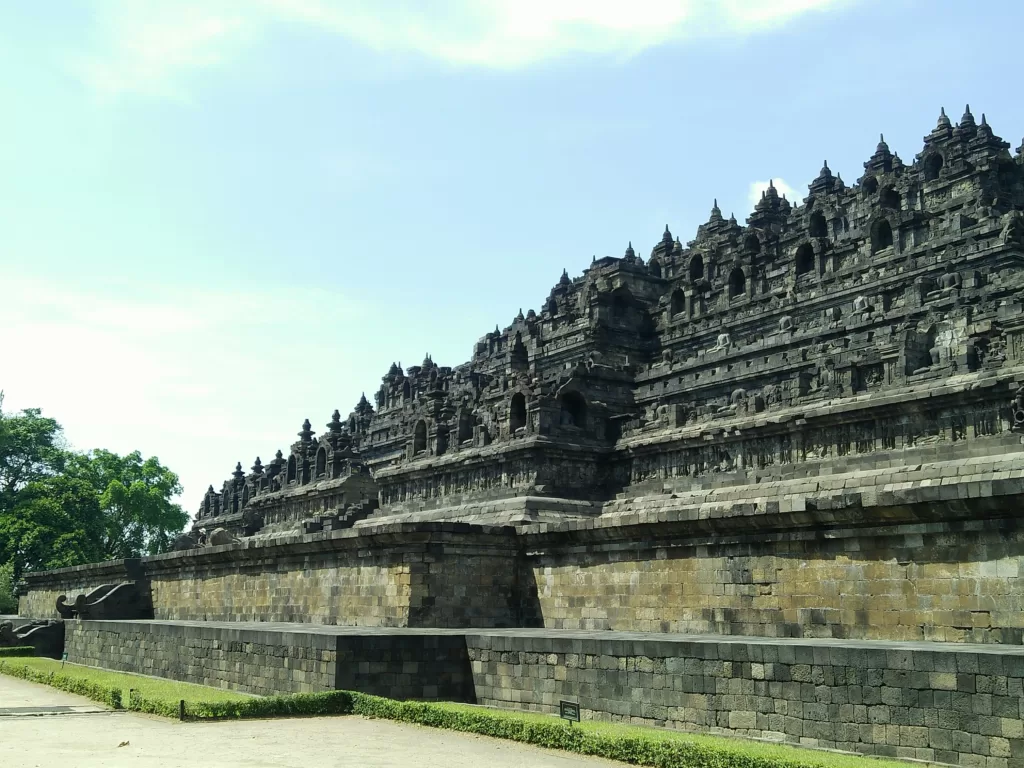
Here are some of the top things to keep in mind before you visit the Borobudur Buddha Temple:
- There are two types of tickets – the Temple Ground ticket, which allows access to the temple grounds only, and the Temple Structure Ticket which allows you to explore the temple grounds and the Borobudur Temple with a guided tour.
- Only a maximum of 1200 people are allowed to purchase Temple Structure Tickets per day, which is divided into 8 entry slots per day, with a maximum of 150 people allowed in each slot.
- Both men and women should have their shoulders and thighs covered. It is important to be respectful of the customs. If you fail to follow this rule, you will be given a free-of-charge sarong to wear.
- The temple is a popular spot, especially among the locals, so you can avoid visiting on weekends and public holidays to avoid the crowds.
- After purchasing the ticket or getting your e-ticket validated, follow the signs towards the entrance of the temple on the eastern side. Show respect by circling the temple three times in a clockwise direction.
- Make sure you wear comfortable shoes as the temple complex covers a lot of area and you will also have to climb a lot of uneven and rugged stairs.
- When you finish your visit, you will exit through the western side of the temple.
Borobudur Temple: Interesting Facts
One of the most interesting facts about Borobudur Temple is that it is a symbol of the union of Heaven and Earth and of Gods and People. The eight tiers of the structure represent the eight steps towards enlightenment, with the first tier representing carnal passions, the next four symbolising the struggle of a person with their desires, the top three tiers signifying the approach to nirvana, and the central stupa at the top symbolising nirvana. Here are some more interesting facts about Borobudur Temple that you may not have known:
- The Borobudur Temple is the world’s largest Buddhist monument and has been built without the use of cement or other adhesives, using volcanic rocks.
- The temple was built without the use of any sophisticated tools and took around 75 years to complete.
- Recognised as a UNESCO World Heritage Site, the temple is also listed in the Guinness Book of Records for being the largest archaeological site for a Buddhist temple.
- The dark grey visage of the temple is because of volcanic ash. According to analysis done by archaeologists, in earlier times, the temple used to be painted with bright colours over a coat of white paint.
- Each of the 2672 panel reliefs in the temple tells a story from everyday life in ancient Java and from Buddhist mythology.
- One of the best hidden gems in Indonesia, Borobudur Temple has been declared as one of the new wonders of the world.
- There is no interior space within the temple, which was built around a hill and lined with stones.
- In 2006, the temple was hit by an earthquake that measured 2.6 on the Richter scale. The earthquake managed to destroy the surrounding area, but the temple was not affected in the slightest.
From the history of the Borobudur Temple to its architecture and the mystery that surrounds it, it is easy to see that it is a must-visit attraction that you must consider including in your Indonesia tour packages.








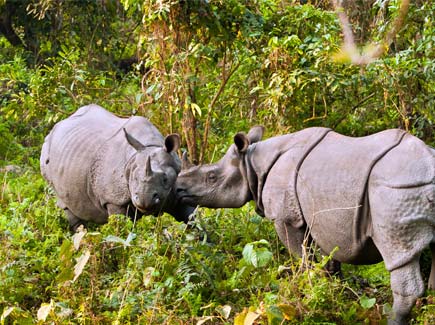





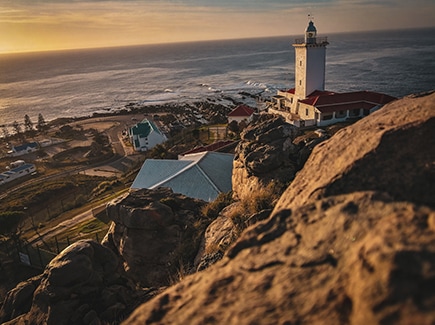



















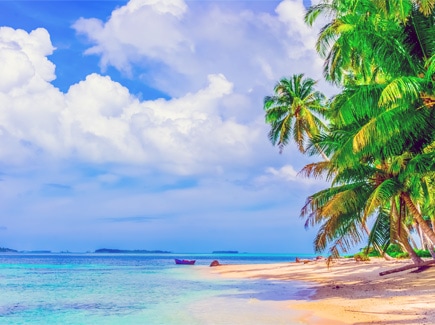

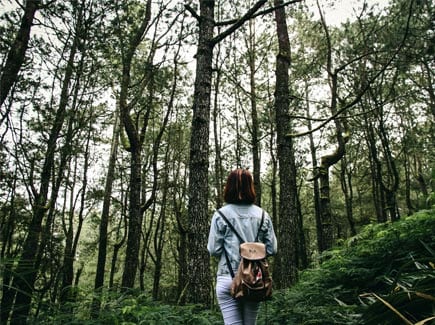
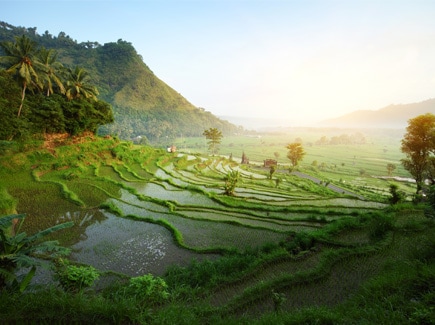
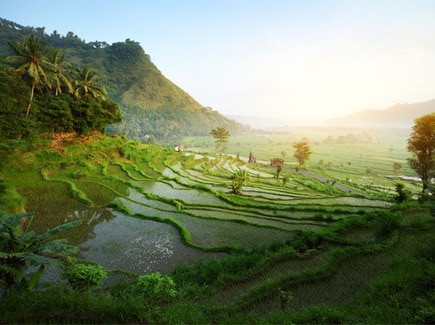













Post your Comment
Please let us know your thoughts on this story by leaving a comment.